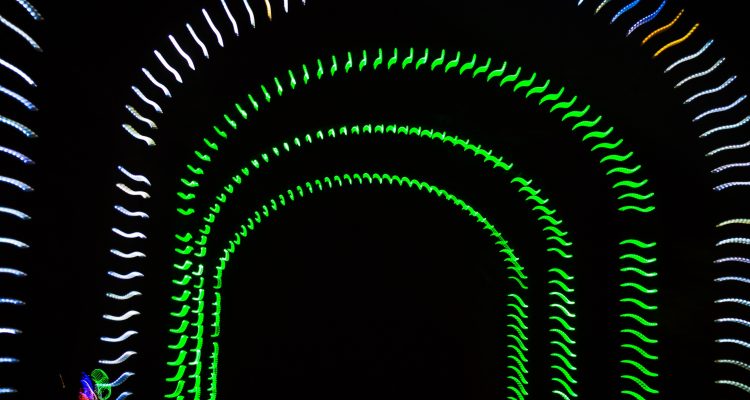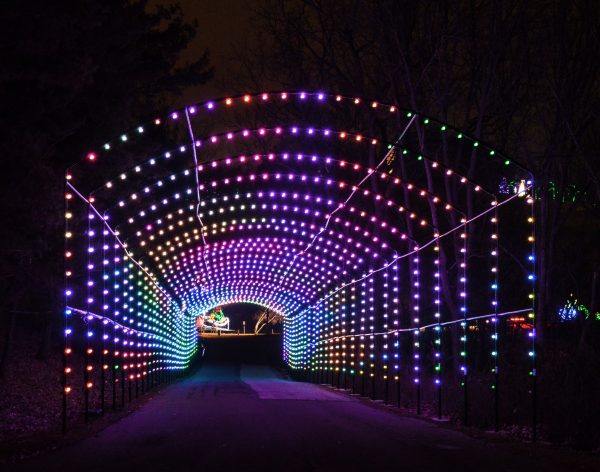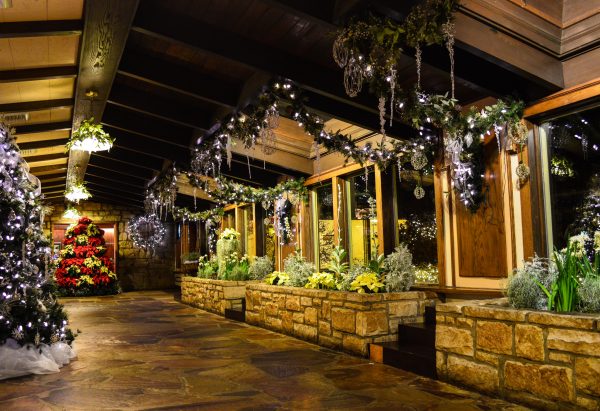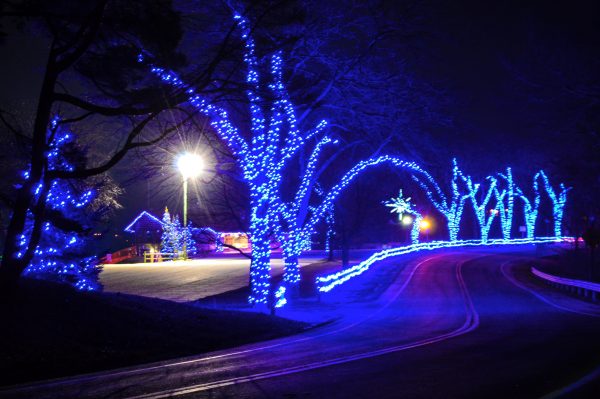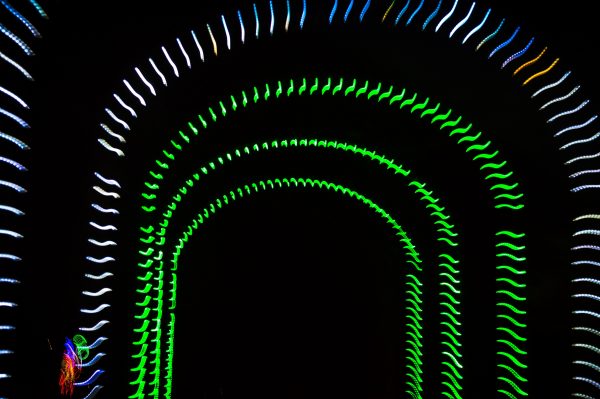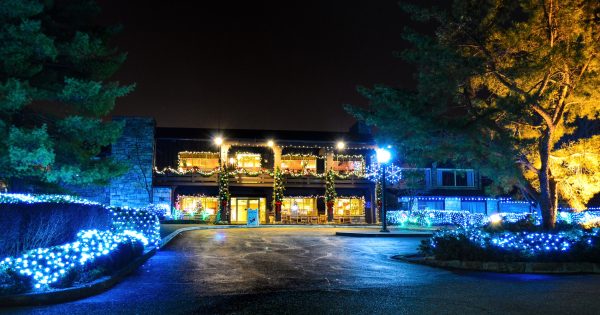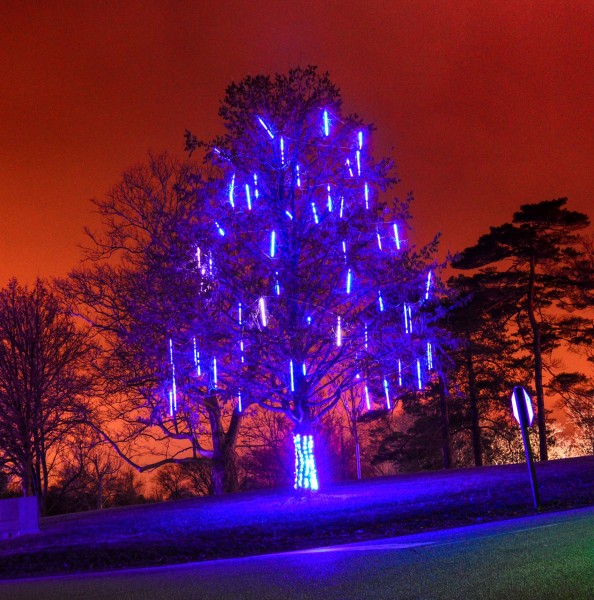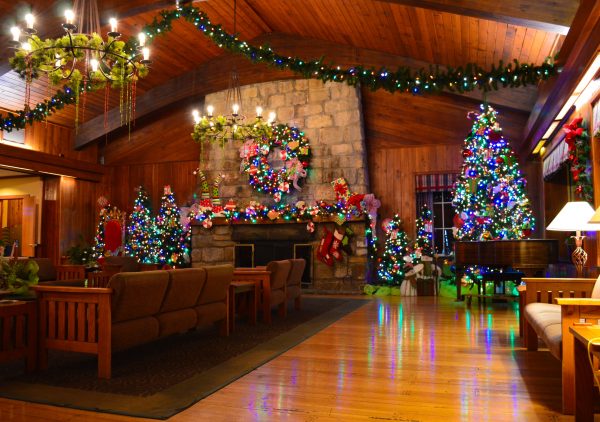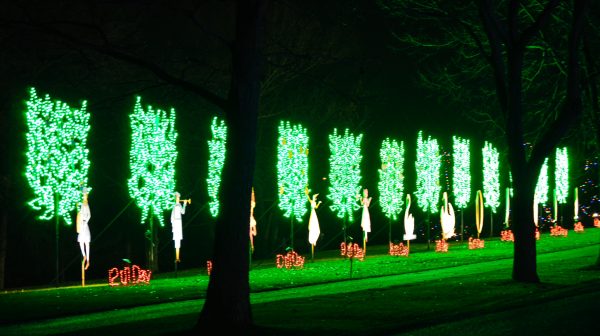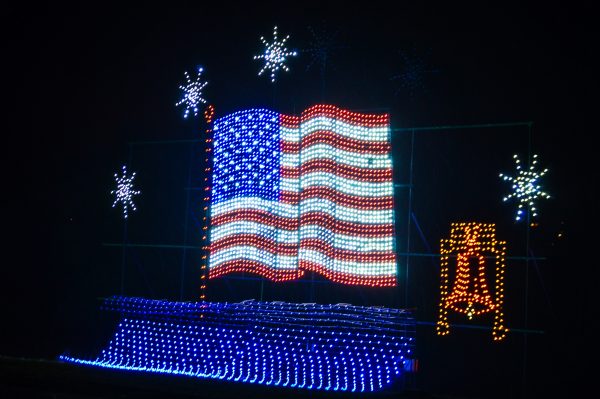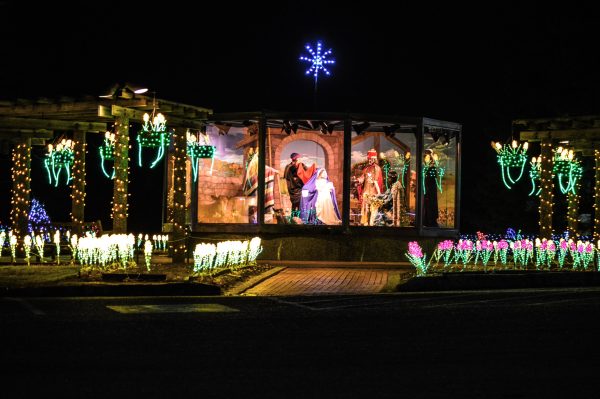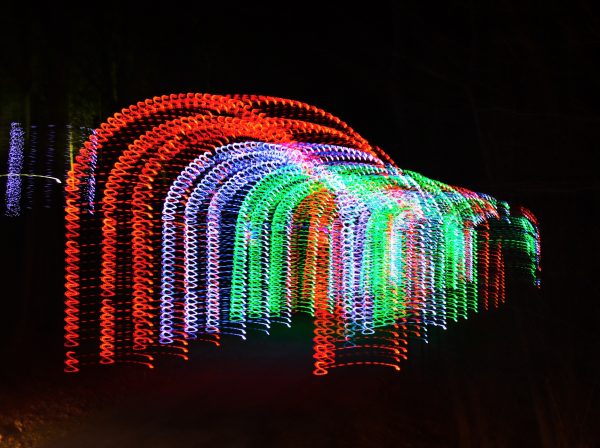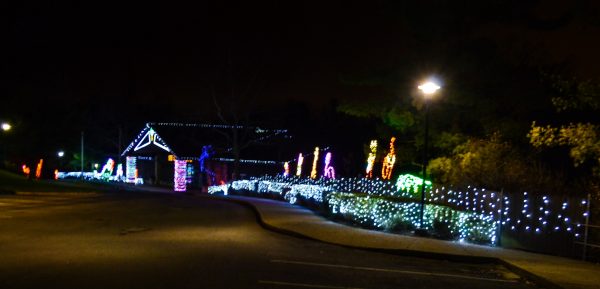By Steve Novotney
Weelunk.com
Bill Koegler would drive from Oglebay Park to the Greggsville section of Wheeling at the bottom of the hill, turn around in the Convenient Food Mart parking lot, and drive back up W.Va. 88.
The next time, Koegler traveled to the end of Bethany Pike. Then he drove on National Road as far as Perkins. And Koegler navigated these routes over and over again.
That’s because he was the measuring stick. Koegler was the general manager of Wilson Lodge in December 1985, when the first-ever Winter Festival of Lights was staged along a two-mile loop in the park.
“Randy (Worls) called me one night and he asked me, ‘How many cars can you see from your front window?’ I looked out and told him that I could see a lot of cars out there,” Koegler explained. “Then he said, ‘Yeah, I can see a lot of cars from my house, too.’
“Then he said, ‘Why don’t you get into your car and go down the hill so you can see how far the traffic extends?’ That’s what I did, and it amazed me. I did that drive almost every Friday and Saturday night, and it amazed me every time.”
It was 1978 when Koegler took over the operation of Wilson Lodge, a hotel that opened its first wing of guest rooms in 1957. Glessner Auditorium was added in 1961, and a second wing of rooms was constructed in 1966. Despite the facility’s intimate hilltop setting in the middle of the property Earl Oglebay bequeathed the Friendly City in 1926, Koegler witnessed the hotel’s occupancy percentage plunge during the months of November and December. One year after another the numbers dwindled until, of course, 1986, 12 months after the inaugural lights festival.
“When I first heard of the Festival of Lights idea, I honestly thought it was a great idea,” Koegler recalled. “I have never known Randy Worls to have a bad idea. He’s the most creative person I have ever met in my professional life, but still no one really knew if a lights festival would work.
“But today, I know mothers and fathers who were kids when the festival first started, and it meant so much to them that they are now taking their kids through the lights,” he said. “It’s become a tradition, and it’s hard to believe it started 30 years ago already.”
Once Wilson Lodge was teeming with activity in the late 1980s, staff members were added, “SOLD OUT” was more common than not, more cottages and new estate houses were constructed, and it always seemed to be high-tide time for the sea of cars and motor coaches.
Today, the lodge offers 271 guest rooms, 58 cottages and estate houses, 15 conference rooms, two restaurants, an indoor pool (Ping Pong table and hot tub included), a gift shop, an arcade for the kids, and even the West Spa for rare pampering. The facility is not affiliated with any hotel chain, instead operating on the “Oglebay Standard.”
“A couple of years after we started the lights, it wasn’t uncommon for us to be serving a buffet to seven buses on one floor and to be serving folks from other buses in other areas, too,” Koegler said. “We even built a parking lot just for the motor coaches.
“And then we had to create events to entertain all of our guests, and one of the things we started was live music for the bus passengers,” he continued. “And a lot of those passengers had the chance to see Brad Paisley perform at the lodge when he was 13 or 14. He did a lot of dates for three years before anyone really knew his name.”
Koegler, now semi-retired, still walks the park and drives his grandchildren through the Winter Festival of Lights. And he possesses many memories, including the one about the hot chocolate sale during which his own son and daughter froze to serve nearly no one. In fact, Koegler admitted the hot chocolate idea may have actually been a bad idea produced by Worls.
But not this one. Not the Festival of Lights.
“That one idea did a lot for Oglebay Park and also the city of Wheeling. There may not be as many buses as their used to be, but everything always changes, and you have to expect that,” Koegler added. “But it still amazes me when I see all of those cars lined up to the interstate, and that’s not because I didn’t think it could be this successful. It’s because of the impact it has and how lucky we are to have it.”
The Invention.
On Dec. 8, 1984, G. Randolph “Randy” Worls and his wife, Betty, invited their longtime friends Ross Felton and his wife to dinner at Wilson Lodge’s Ihlenfeld Dining Room. Worls was CEO of Oglebay Park, and Felton was the general manager of WVVA and Jamboree USA.
And the four of them were the only guests.
“The dining room was empty except for the staff and for us,” Worls remembered. “So figuring out how to increase the number of people in Oglebay was the main topic of conversation that evening. We knew we had to figure out something.”
The same was true for the legendary Jamboree USA, a country music concert series staged at the Capitol Music Hall each Saturday in downtown Wheeling for several decades. Once the colder weather arrived along with the holiday season, attendance dramatically diminished.
“At that time of year back then, we were lucky to have 100 people attending the Jamboree,” Felton said. “We had to continue with the shows because taking a hiatus was not an option then, so we were just moving forward with the shows.”
Conversation after conversation, Felton and Worls traded their ideas, and then the pair traveled to Charleston to attend the 1985 Governor’s Conference on Tourism.
“Half of that day was taken up by a tour bus company operator name Ed Camaro. Ross and I both attended that session, and it impressed us,” Worls explained. “Tour buses back then were a very big deal. That may not be true today, but it was true in the early to mid-80s.
“That’s why Ross and I agreed to bring this guy in as a consultant so we could figure it out,” he continued. “And that’s when we asked him the big question: “Where do you send your tour buses in the months of November and December?’
The answer?
“‘We send them to Niagara Fall, N.Y., but not for the falls,’ Worls recalled. “That was his answer. He then explained to us that he sent his buses there for the Festival of Lights, and we immediately asked him to explain it. It was a downtown show centered on a civic center, some entertainment, and there are also a number of stores.”
“They had a bunch of the buildings lit up, and there was Christmas music. It was very festive, and right across the street there was this huge city center, so it all went together,” Felton said. “It all seemed very natural for us, so we started asking a lot of questions, and they were very cooperative. We had a lot of phone meetings with them, and it helped us a lot, but what we had planned for Oglebay was a very different event.”
Soon after the conference, Worls and the late Robert Otten, a longtime creative director of the Wheeling Park Commission, discovered landscape-lighting expert Dick Bosch, a native of the Netherlands. Bosch designs the illuminations for many trees and buildings, and Otten designed the first five lighting displays for the first show. Otten created nearly 50 additional displays before his unfortunate passing in 2005.
“In the beginning, we had some resources available to us that got us started with the hope that it would evolve the way it has since,” said Worls, who now works with the Oglebay Foundation. “John Karras was in the Legislature at the time and got us a grant to do some infrastructure for the first year of the Festival of Lights.”
The first evening for the Winter Festival of Lights took place on Dec. 2, 1985, and Mother Nature was not kind.
“We really had no idea how the first year was going to go because it had rained for 30 straight days before it opened,” Worls recalled. “Plus, we had a big storm and the electricity was out all around the park, but we had power somehow, so we were able to turn the lights on. There was a lot of pressure at first because Ross had taken a huge risk and booked a lot of different shows that people had to pay for a year in advance, but it worked well the first year, and then the second year it really took off.”
And that’s because the passengers of the very first motor coach were awed by the show.
“The first tour bus visiting the Festival of Lights appeared out of nowhere 10 days into the show, and we had about 50 total tour buses that first year. But then during the second year we received over 600 calls from tour bus operators. That told us that we’d better find some more money and get the Speidel area involved with the show.”
Karras came to the rescue once again, politicking for grants for the festival to the tune of $250,000, and the expansion quickly took place thanks Oglebay’s partnership with Wheeling Park High School. Since the beginning, Park students have constructed Otten’s designs.
But not everyone was pleased with the park’s decision to offer the lights show because of the traffic congestion along W.Va. 88, Warden’s Run Road, and G.C. & P. Road, including residents of the Woodsdale, Greggsville, and Lee Drive areas of Wheeling.
“We started receiving complaints the very first year because the cars would get backed up down over the hill,” Worls said. “It was the second year when they started backing up to Interstate 70.
“We did everything we could do to make the public aware of the traffic situation by working with local media outlets and making some rules concerning the flow of the show’s traffic,” he continued. “I also think the affected residents learned their way around, and that made it easier for them, too.”
Many believe Felton and Worls traveled to Niagara Falls prior to that very first evening of lights, but that is not true. In fact, the pair did not visit their new friends – and soon to be arch rivals – until after the second year.
“I think some folks think we went up and stole their ideas, but that’s not how it happened,” Worls said. “Really, we didn’t even need to see their displays or the setting because we knew our show would have to be completely different because of the setting for our show and because we decided the lighting displays would be unique to our area.
“It was a co-venture that made it work, but we weren’t sure ourselves how it was going to work,” Worls said. “And I can tell you that it has gone far beyond what we anticipated in the very beginning, and that doesn’t happen very often. You may think you have a good idea, but then you get defeated because of the obstacles you didn’t anticipate.”
The Lights Glowed, and the Money Flowed.
Felton’s goal was the same possessed by Worls, and drawing more people to the Upper Ohio Valley meant additional revenue generation for Jamboree USA. Once the Festival of Lights was a proven product after the first year, Felton instructed his staff to add country music shows to the Capitol Theatre’s schedule of events.
His idea was packaging. Felton believed potential patrons wanted more of a reason to attend the concerts, and he was convinced the Festival of Lights would lead busload after busload to Main Street in downtown Wheeling.
And Felton was correct.
“I can remember one weekend we had Charlie Pride at the Jamboree, and he agreed to do four shows in one weekend. That’s how busy we were. It was a night-and-day thing for us,” he said. “Charlie did one show at 2:30 p.m., and then at 5 p.m., another at 7:30 p.m., and the last one started at 10 p.m.
“We also had some weekday shows at that time, and people would stay over, and the hotels were filled all of the time,” Felton continued. “And that was because of the Festival of Lights. There was just a lot of demand from people who wanted to come here and see what was going on, and it all goes back to our discussion with Ed Camaro, the tour bus operator. Having that package to offer them was the key to the success.”
The economic impact was not limited, though, to Jamboree USA and Oglebay Park. Stores, gas stations, hotels and restaurants also realized the new spike in business. In fact, Worls and his employees started working with local business owners in an effort to spread the wealth.
“George Boury called me after the first year and said, ‘Well, I’m sorry to tell you this, but we didn’t do any better at the National Road Elby’s than we did last year at this time,’ but then the second year he admitted that their sales had doubled, and then it tripled after that,” Worls said. “That was the same case with most of the other restaurants, and that’s because there was suddenly a huge number of people coming into Wheeling for the Festival of Lights.
“The Festival turned Oglebay’s business at that time of year completely around. What were once the worst two months of the year quickly became our two best months of the year,” he continued. “And today it’s even more critical because of what it takes to operate this park each year, and I don’t think people realize that the parks are not profitable ventures.
“The parks have never, ever made money. Ever,” Worls reported. “There has never been a year that the parks have broken even just based on the revenue that’s been generated within them. Never. If we didn’t have the Festival of Lights, I can tell you that we would have to do some serious cutbacks within the parks system.”
Although Jamboree USA is no longer offered at the Capitol Theatre because the current owner, Clear Channel Communications, decided to shutter the series in 2006, Felton confirmed that the Festival of Lights packages reinvigorated his operations for many years.
“The Festival of Lights did a lot for us as far as building a great reputation with the decision-makers in Nashville,” Felton revealed. “It was a very big boost for us because of the caliber of talent we were able to start booking for our shows.
“Although some of the merchants in downtown Wheeling were not too happy with us because we were parking the buses along the streets of the downtown, the Festival of Lights supplied a very big boost for us, and that allowed the Jamboree to continue for another couple of decades.”
Even though the number of motor coaches has declined during the past 15 years, the annual lights show remains vital to the economic health of the city of Wheeling, according to the Friendly City’s mayor, Andy McKenzie. McKenzie’s grandparents, Doc and Chickie Williams, were frequent Jamboree performers and he and his family operated a retail shop across the street from the Capitol Theatre.
“I remember the beginning very, very well because of the traffic and because of the added business for my grandfather and the rest of the city,” he said. “But I think the Festival of Lights is just as important today to our businesses as it was during the 1980s and 1990s, and that’s because it increases the amount of non-local dollars that’s flowing in.
“When people stay at our hotels, the residents of Wheeling benefit because half of those dollars are used for recreation, and when they visit our restaurants, it generates funds for Wesbanco Arena, our local infrastructure, and our police and fire departments,” McKenzie said. “The city of Wheeling has always been very supportive of the Festival of Lights, and that’s for very obvious reasons.”
The Wheeling Convention and Visitors Bureau also benefits from the collection of the city/county 6 percent hotel/motel tax collection, receiving 50 percent of what is collected. Frank O’Brien, the CVB’s executive director, also acknowledged the importance of the Festival of Lights.
“The number of hotel and motel rooms that are rented has always increased in November and December, and that’s thanks to Oglebay and also to the people operating our local hotels,” he said. “It’s all about packaging a number of attractions and events that the visitor can do while here.
“It’s become a constant that the CVB counts on each year and that many local attractions count on, too” O’Brien added. “The best part is that the festival gets better and better every year.”
The Life of the Lights.
Today, Oglebay’s Winter Festival of Lights covers more than 300 acres along a six-mile drive. Along with 80 displays, Oglebay also decorates Wilson Lodge, the Oglebay Mansion Museum, and the Carriage Glass House, and the Good Zoo offers two lighting shows synchronized to music.
The resort also offers the “Gardens of Light,” complete with more than 150 hanging, lighted baskets as well as thousands of illuminated flowers and trees and the “Christmas Tree Garden” with 30 live, decorated trees near its life-sized Nativity display. Oglebay also adds to the annual show each year, and this year a new, 300-foot light tunnel was constructed for the roadway leading from the zoo to Schenk Lake.
And yes, there are more than 1 million lights glowing each evening.
According to Oglebay Resort’s website, the lights show “…was listed as one of the 10 Best Christmas Light Displays in the US according to AOL Travel. The show is also listed on the American Bus Association’s Top International Events, was named as a top 100 event by Eventcrazy.com, and was recently listed as one of the top 200 events in the country by Discover America. The Festival of Lights was also featured on the Travel Channel’s Extreme Christmas Celebrations and was named one of the top 10 best holiday light and tree shows by HotelsCombined.com, a leading hotel search engine.”
Beginning in 2008, Oglebay officials initiated a “green” effort to replace all of the traditional lights to more energy-efficient LED bulbs, and six years later all included displays have been transitioned.
“It’s not as easy as it sounds, and that’s because of the difference in the price for the lights,” Worls explained. “For example, we used to be able to buy the regular Christmas light by bulk and pay about 7 cents for each. But the LED lights are close to 75 cents each, and they do last longer, and they keep their color much better than the original lights we used.
“When we first started changing the bulbs to the LEDs, we did receive some complaints because the LEDs are brighter than the traditional ones,” he said. “But I think our visitors are used to the new ones now, and I think they have realized that the transition was best for everyone involved.”
Following the second year, Worls and his colleagues decided in 1987 to set up a booth to collect donations from those attending the lights show. The first donation request was $5, and today the request is $20.
But …
“It’s a donation, and it’s not necessary that the visitors make that donation,” Worls said. “If they want to put a dollar in the pot, they can put a dollar in the pot. It’s only a request, but it’s a free show. They don’t have to put anything in there.
“I believe about 90 percent of the visitors do donate something toward the show, but if you don’t want to, you don’t have to,” he said. “Those donations average around $400,000 per year, and the show costs about $800,000 per year, so close to 50 percent of the show is paid for by those donations.”
Through the last three decades, Worls has seen several communities in Pennsylvania and Ohio follow Oglebay with the creation of lighting displays, but the only competing show that has attracted the attention of Oglebay’s staff since 1985 is the one in Niagara Falls, N.Y.
“The people from the Niagara Falls Chamber of Commerce would release these attendance figures claiming that they had 500,000 people, and we knew we were up in that neighborhood, too,” Worls said. “So we would always wait until after they released their stats, and then we would always up them by 50,000. We didn’t know if that was true, but neither did they.
“The fact of the matter is we never had anywhere close to those numbers and neither did they up in Niagara Falls. It was a PR thing back and forth,” he admitted. “I can recall one year they came out with 900,000 visitors, and we looked around and saw cars lined up all the way to the interstate, so we made it a million.”
To make it “real,” so to speak, Worls decided to award a prize package to the alleged one millionth individual to navigate the festival.
“Mary Hamm and I were in position to select the millionth visitor, and we arbitrarily picked this one car with a couple in it,” Worls explained. “So we asked the driver of the vehicle to pull to the side of the road, and then we said, ‘You and your wife are our millionth visitor and you get a free weekend at Wilson Lodge with meals included. And that’s when the man said, ‘That’s not my wife.’
“We then waited until we saw this van that had a grandmother in the backseat and we made them No. 1 million,” he said. “And that’s a true story.”
No longer does the Winter Festival of Lights attract thousands of motor coaches, but not because Oglebay’s event went stale. The traffic congestion continues to extend along Wheeling streets to Interstate 70 a few evenings each December and January, and Friendly City restaurants, hotels, and gas stations continue to benefit.
“Tour bus traffic fell nationally at the same time we saw a drop,” Worls explained. “The generation before the Baby Boomers enjoyed tour buses very much, but they apparently are not as popular with the Baby Boomers.
“At our peak, we welcomed nearly 2,500 tour buses to Oglebay for the Festival of Lights,” he said. “This year we will welcome between 800-900 buses, which is an increase from recent years. In fact, we will see an increased number of overnight tour buses this year for the first time in many years.
“Unless the weather changes for the worse, this year looks like it’s going to be a record year. That’s based on dollars produced, the number of cars that go through and the occupancy for Wilson Lodge. Overall, I believe we’re going to realize a record year, and we have reached the point now to where we are either the top-rated light show in the United States, or the second best show. We seem to complete against Branson, Mo., each year.”
Hundreds of couples have staged their weddings within the Winter Festival of Lights; the Top Three displays, Worls believes, are the Poinsettia Wreath, the Cinderella display, and The Twelve Days of Christmas; the public should expect even new light tunnels in future years; and the public also should know there’s no end in sight.
“I can say, in all honesty, that if Ross Felton would not have shown interest and excitement for the show after that Governor’s Conference on Tourism, we probably would not have pursued doing a Festival of Lights,” said Worls, twice selected as the Grand Marshall for the Perkins Restaurant – Fantasy of Lights Christmas Parade. “But when he said he would be very interested in this event, it gave us the inspiration to move forward with doing all of the research to find out what we needed to find out.
“And my wife and I had dinner with Ross and his wife just the other night, and the Ihlenfeld Dining Room was pretty darn crowded,” he added. “So I guess we did something right.”


